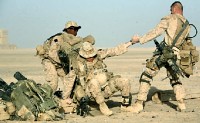The purpose of the mission – - dubbed Operation Khanjar or “Strike of the Sword” – - is to rout out the Taliban forces before the August 20 election to ensure the re-election of Afghan President Hamid Karzai.
The Marines are encountering stiff resistance from the Taliban who have been newly energized under the leadership of Abdul Qayum Zakir, also known as Abdullah Ghulam Rasoul, and several of his friends from the detention facility at Guantanamo Bay (GITMO), including Mohammed Nayim Farouq, and Abdul Rahman
These insurgents were released from GITMO to the custody of Afghan President Hamid Karzai, who promptly freed them in an effort to gain the widespread support for his re-election bid.
The Karzai tactic backfired.
The released GITMO prisoners have assumed command of the Taliban army, and have succeeded in making July 09 the bloodiest month in the 8 year old Afghan war.
Several terrorists who rejoined the Taliban after spending some time at GITMO have bit the dust and are presently enjoying the seventy two houris in seventh heaven.
The list of such so-called “martyrs” includes Abdullah Mohsud, who blew himself up in order to avoid capture by Pakistani forces in 2007; Maulvi Abdul Fhaffar, who preceded Zakir as the Taliban regional commander in the Helmand and Uruzgan Provinces of Afghanistan; and Yousef Muhammed Yaaqoub, who executed a jailbreak in Kandahar, and led an attack on the border town of Spin Boldak.
Other GITMO grads who returned to attack the US and NATO forces have been recaptured. Mohammed Ismail, for example, was one of the “juveniles” released from the detention facility in 2004. During a press interview after his release, he described the Americans saying, “They gave me a good time in Cuba. They were very nice to me, giving me English lessons.” Ismail concluded his interview saying he would have to find work once he finished visiting all his relatives. He was recaptured four months later in May 2004, participating in an attack on U.S. forces near Kandahar. At the time of his recapture, Ismail carried a letter confirming his status as a Taliban member in good standing.
Zakir, according to The London Times, was one of the 500 terrorists who were released from GTMO by the Bush Administration. He had been captured in the chaos of the Taleban surrender at Kunduz, northern Afghanistan, in December 2001. Zakir was in the lead car of a convoy of senior Taleban leaders. He was carrying a Kalashnikov and two Casio watches later identified as key components of home-made bombs.
When questioned, Zakir denied that the watches were his, but it now appears likely that they were evidence of his expertise in bombmaking . He spent six years at GITMO until a U.S. military review board decided to return him to Afghanistan.
In Afghanistan, Zakir was held in Pul-e-Charkhi maximum security prison in a block that had been renovated by the Americans for hard-core terrorists.
Zakir spent less than three months in the Afghan slammer before he was freed early in 2008 upon special orders from President Karzai.
With Zakir in command, the “asymmetric” threat from the Taliban has risen dramatically, with greater numbers of more sophisticated and powerful roadside bombs used against British troops. “He is a serious player,” one Whitehall official said.
The same official believes that Zakir was the mastermind behind the deadly surge in roadside bombings that have occurred in Helmand since his release. In 2008, there were 3,276 improvised explosive devise (IED) attacks in Afghanistan, a 45% increase over 2007, and a record for the war. In the first two months of 2009, attacks with IEDs have killed 36 foreign troops, triple the number for the same period in 2008.
In April 2009, Zakir launched Operation Nasrat (”victory”) against the occupying US and NATO forces and pledged to use “ambushes, offensives, explosions, martyrdom-seeking attacks, and surprise attacks.” He also issued warnings that they would attack “military units of the invading forces, diplomatic centers, mobile convoys and high-ranking officials” of the Afghan government.
Responding to this threat, the Obama Administration initiated “Strike of the Sword,” an invasion of the Helmand Province by 4,000 Marines and 650 Afghan soldiers.
The London Times quoted British authorities as saying that Zakir’s emergence as the leader of the Taliban will complicate further President Obama’s efforts to persuade countries to take in Guantánamo detainees and allow him to close the camp within a year as promised.
Zakir was born and raised in the Helmand Province, an area lush with opium poppies now in full bloom.
The Taliban is funded by Afghan’s poppy crop which provides 90% of the global supply of heroin.
As U.S. Marines move through Helmand, they have been ordered to skirt around the poppy fields in order not to harm or destroy this year’s bumper crop. The poppies remain the sole staple of the Afghan economy and any damage to the crop would produce an outcry from the peasants and drug lords that could result in an increase in anti-American sentiment.
The Obama Administration remains determined to deploy 68,000 additional U.S. troops before the “democratic” elections are scheduled.
Dr. Paul L. Williams——
Bio and Archives
Paul L. Williams, Ph.D., is the author of such best-selling books as The Day of Islam, The Al Qaeda Connection, Osama’s Revenge: The Next 9/11, The Complete Idiot’s Guide to the Crusades and The Vatican Exposed. An award-winning journalist, he is a frequent guest on such national news networks as ABC News, CBS News, Fox News, MSNBC, and NPR.
Older articles by Dr. Paul L. Williams
 -A dog returneth to its vomit.
So reads Proverbs 26:11.
Any doubt of this truth should be put to rest by recent developments in southeastern Afghanistan where the US Marines have launched a massive offensive.
-A dog returneth to its vomit.
So reads Proverbs 26:11.
Any doubt of this truth should be put to rest by recent developments in southeastern Afghanistan where the US Marines have launched a massive offensive.